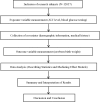The effect of early pregnancy ALT elevation on neonatal birth weight: The mediating role of gestational diabetes mellitus
- PMID: 40367133
- PMCID: PMC12077732
- DOI: 10.1371/journal.pone.0322581
The effect of early pregnancy ALT elevation on neonatal birth weight: The mediating role of gestational diabetes mellitus
Abstract
Elevated serum alanine aminotransferase (ALT) levels in early pregnancy and gestational diabetes mellitus (GDM) are linked to an increased rate of large for gestational age (LGA) births. Additionally, elevated ALT levels raise the risk of developing GDM, but it remains unclear whether GDM mediates the effect of ALT on neonatal birth weight. This study examines whether GDM mediates this relationship. We conducted a retrospective cohort study with participants from Jinxin Women's and Children's Hospital who delivered single live births between 2020 and 2023. A multifactorial logistic regression model assessed the relationship between early pregnancy ALT levels, GDM incidence, and LGA births. A mediation model evaluated GDM's role in the impact of elevated ALT on neonatal birth weight. Our study included 12,057 patients. After adjusting for confounders, the difference in LGA rates between elevated and normal ALT groups was significant (OR: 1.248, 95% CI: 1.001-1.556, P = 0.049). The GDM incidence difference between these groups was also significant (OR: 1.564, 95% CI: 1.306-1.873, P < 0.01), as was the LGA incidence difference between GDM and non-GDM groups (OR: 1.306, 95% CI: 1.129-1.511, P < 0.01). After adjusting for confounders, we found that elevated ALT levels in early pregnancy and GDM both affected neonatal birth weight. Specifically, elevated ALT levels had a direct impact on neonatal birth weight (β = 0.0291, 95% CI: 0.0100-0.0635), while GDM had an indirect effect (β = 0.0025, 95% CI: 0.0012-0.0056), with GDM accounting for 8.1% of the mediation effect. Our study shows that GDM partly mediates the effect of elevated ALT on neonatal birth weight, highlighting the importance of early ALT and glucose screening in routine prenatal care. Healthcare providers should consider including ALT testing in pregnancy protocols and focus on blood glucose control in patients with elevated ALT to reduce the risk of LGA births.
Copyright: © 2025 Ma et al. This is an open access article distributed under the terms of the Creative Commons Attribution License, which permits unrestricted use, distribution, and reproduction in any medium, provided the original author and source are credited.
Conflict of interest statement
The authors have declared that no competing interests exist.
Figures


Similar articles
-
Gestational diabetes mellitus in previous pregnancy associated with the risk of large for gestational age and macrosomia in the second pregnancy.Front Endocrinol (Lausanne). 2025 Feb 3;16:1474694. doi: 10.3389/fendo.2025.1474694. eCollection 2025. Front Endocrinol (Lausanne). 2025. PMID: 39963281 Free PMC article.
-
The association of gestational diabetes mellitus with fetal birth weight.J Diabetes Complications. 2018 Jul;32(7):635-642. doi: 10.1016/j.jdiacomp.2018.04.008. Epub 2018 Apr 25. J Diabetes Complications. 2018. PMID: 29907325
-
Birth weight and large for gestational age trends in offspring of pregnant women with gestational diabetes mellitus in southern China, 2012-2021.Front Endocrinol (Lausanne). 2023 May 4;14:1166533. doi: 10.3389/fendo.2023.1166533. eCollection 2023. Front Endocrinol (Lausanne). 2023. PMID: 37214242 Free PMC article.
-
Association between prepregnancy body mass index or gestational weight gain and adverse pregnancy outcomes among Chinese women with gestational diabetes mellitus: a systematic review and meta-analysis.BMJ Open. 2024 Feb 17;14(2):e075226. doi: 10.1136/bmjopen-2023-075226. BMJ Open. 2024. PMID: 38367974 Free PMC article.
-
Screening and diagnosing gestational diabetes mellitus.Evid Rep Technol Assess (Full Rep). 2012 Oct;(210):1-327. Evid Rep Technol Assess (Full Rep). 2012. PMID: 24423035 Free PMC article. Review.
Cited by
-
Gestational diabetes mellitus remains the risk factor for neonatal adverse outcomes in multiparous women.Front Pediatr. 2025 Jun 13;13:1573470. doi: 10.3389/fped.2025.1573470. eCollection 2025. Front Pediatr. 2025. PMID: 40584592 Free PMC article.
References
MeSH terms
Substances
LinkOut - more resources
Full Text Sources
Medical

